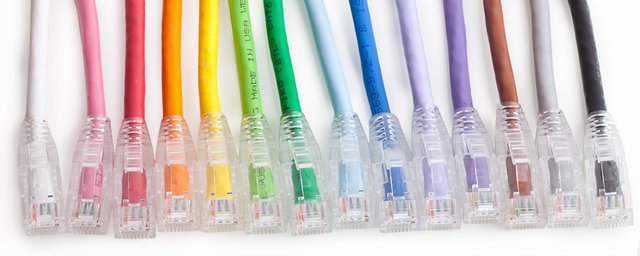A Simplified Approach: LAN Cable Construction and Basic Network
)
Have you ever asked yourself, How did those LAN cables are being constructed/terminated? and What are these kinds of cables to be used properly? I know many of us have seen these types of cables and the ones we are actually using right now that is connected to your routers in order for the computers/laptops/other gadgets to have an Internet access. So today let me tell you what are my objectives.
OBJECTIVES
- To make a LAN cable using CAT6 and RJ45 in accordance with T568A and T568B
- To check if the LAN cables (Cross-Over and Straight-Through) are properly terminated using LAN Tester and Multimeter.
But before anything else, let us know first what are these types of LAN cables that we will construct in order for us to be guided. First,
Straight-Through Wired Cables
This type of wired cables are the most commonly used when it comes to host to client connections. So let us talk about the construction of this type of cable, each pins of the connector A and connector B are with the same color of the wire connected, that is why it is called as the Straight-Through Wired Cable.

As you can see in the Image above that each pins are connected to the same pins on both connectors. Each connectros are T568B Terminated. When we say connectors, those are the RJ45 that we will be using right now. I'll give you an overview with that later. So let's move on for the next type of LAN cable. Second,
Crossover Wired Cables
Another type of LAN cable is somewhat alike with the Straight-Through Wired Cables but the Transmitter (Tx) and the Receiver (Rx) lines are being crossed that is connected with opposite positions on either of the cables end. So we are using the T568B Standard as an example. As you can see that the Connector A is the same color sequence with the Straight-through Wired Cable connectors, but it is being connected crisscrossed to the Connector B.

And the last type of LAN cables are,
Rollover Wired Cables
These cables are sometimes called as rollover cables and it is just the assignments of pins are opposite at the very end of the cable and the same with the word "rolled over". But in this activity we haven't tried to construct the rollover. Because the objectives are just the crossover and the straight-through. But to give you an brief review more on rollover wired cables,
Rollover cables, other name is Yost cables are used most often in devices console port connections to make changes in programming the device. This type of LAN cable is not similar to straight-wired cables and crossover, rollover cables are not intended to carry data but instead create an interface with the device.

Some of you might ask these Questions:
When to use a Straight-Through Cable?

The Straight-through cable is often used in connecting most computers, laptops, printers and other devices that acts as a network clients to the host devices such as router switch or hub and cable modems. In other words it is used for connecting two dissimilar devices together. The one you are using right now with your Internet access/connections with your router to your PC is the Straight-through cable.
When to use a Crossover Cable?

The Crossover Cable is used for connecting two similar devices together: examples are two computers, host to host connections (using both network interface controllers) or two switches to each other. And we can communicate using their IP address. And to understand more about crossover click this link.
Types of Connections in a LAN
Identifying the pin-out of the straight-through and cross-over cables.
So let us go back to our main objectives here.
OBJECTIVES
- To make a LAN cable using CAT6 and RJ45 in accordance with T568A and T568B
- To check if the LAN cables (Cross-Over and Straight-Through) are properly terminated using LAN Tester and Multimeter.
CONSTRUCTING A LAN CABLE:
In this post, we need to know all the factors when it comes to cabling that needs to be considered. So what are the materials needed..
MATERIALS NEEDED:
- Unshielded Twisted Pair (UTP CABLE) - in this activity we used a CAT6 Cable (category 6)
- CRIMPER - used to tightly squeeze the opening against the wire depending on the connector that is being used.
- BOOTS - used to cover/protect the RJ45 and to easily troubleshoot, color coding boots should be applied.
- RJ45 CONNECTOR - used for the termination of the stranded wire/twisted pair wire inside a UTP CABLE where the wires are being crimped/joined.
- LAN TESTER - used for testing both ends of the cables if it is successfully terminated.
- MULTIMETER - used for troubleshooting/testing both ends of the connectors if there is lost connections.
WHAT ARE THE STEPS
Step 1. Before we start insert first the Boots in the UTP Cable then we need to cut a CAT6 Cable and in order to avoid additional cost, we need to have correct measurements to avoid shortened lengths/lapses. In this activity we used a meter of UTP just for activity completion purposes. And now, lets begin with cable jacket stripping that measures approx. 1 inch from the end.

CAUTION: Proper Stripping should be minimized so the jackets of the conductors will not be damaged/cut through. And to avoid short out.
Step 2. After you are done stripping the cable jacket. We need to separate all the conductors/twisted pair wires. and perform the proper sequence/positions of each colored wires.. And in this activity I am doing the T568A Termination. You can also use T568B Termination if you like. Just follow the color sequence.
Step 3. We need to be careful so that colored wire is in the proper order. Then let us trim the conductors to prepare it for the RJ45 Connector. By cutting the conductors half an inch we can have a good possible outcome in terminating.

Step 4. Now let us insert the conductors with color arrangements to the RJ45. And in order to avoid distortions/loss/iterference the UTP Cable jacket should be inside the RJ45. Also for proper presentation of cable. With a little force in pushing the condutors inside the connector to have a good quality LAN cables.
Step 5. Now let us use the Crimper to tightly squeeze the wires to the RJ45 conductors and check if it is properly crimped. Insert the cable with the RJ45 Connector then proper force is needed to have a good terminations. And always check your conductors together with the connector.

With the same procedures. Apply to the other end of the utp cable the T568B because in this activity I am constructing a Crossover Cable. So follow this color sequence and apply the above steps.
Step 6. When you are done with both ends. Try to test your cables connection using a multi meter. And then using a LAN Tester. Insert both connectors end to the LAN Tester. And see the results.
VIDEO FOR THE CROSSOVER CABLE TESTING:
VIDEO FOR THE STRAIGHT-THROUGH CABLE TESTING:
BASIC NETWORK
Just a quick overview on how basic network works. Using the Crossover Cable that I made and Using two (2) Computers to communicate using their IP Address. You can also use a LAPTOP & COMPUTER tandem.
FIRST: Connect both ends of the crossover cable to the computers port . And wait until the LED to turn on after seconds.
SECOND: In the computers keyboard, press WINDOWS (LOGO) + R then type CMD and press ENTER
then type ipconfig to see the computers IP Address.
Once you have both IP addresses, try to communicate each other using 'ping IP Address'
And you shall receive a reply from the other computer because you are using its IP address.
We can see that the other computer is pinging with the other computer. This could be a good start to basic network.
By this article, I am hoping that you have learned something new and I hope this will help you out. I bet the questions inside your mind are already been answered by this post.
So thats all for now. Thank you for your time reading.
Have a productive Day ahead!
Be a member on our Facebook page -- Click this Link
This is your steem friend,
- Niño M.
@eceninzz














I have one thing to add up, most devices now has Auto MDI-X technology to detect where are both sides of cable connected and logically "cross-overing" it. Using a crossover cable is not nessesary unless we need to interface with older hardware.